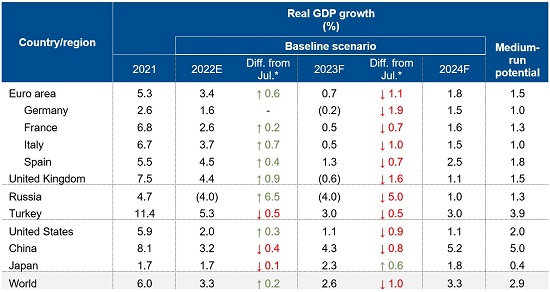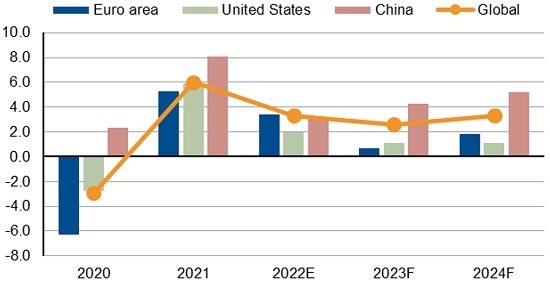Announcements
Drinks

Sovereign Outlook 2023: rating pressures rise due to war in Ukraine, slow growth, high inflation
More sovereign borrowers have faced downward than upward rating action since the escalation of Russia’s war in Ukraine in February with inflation still running high, says Scope Ratings.
“Our overall sovereign outlook for 2023 is Negative, indicating higher likelihood of ratings downgrades next year than ratings upgrades,” says Giacomo Barisone, head of sovereign and public sector ratings at Scope. More than 20% of Scope’s publicly rated sovereigns are on Negative Outlook, compared with 11% on Positive.
“We expect a ‘new normal’ of volatile growth, with next year’s growth globally declining below its potential rate of 2.9%,” Barisone says.
Scope’s global projections (Figure 1) assume near-stagnation of the euro-area economy (0.7%), slow growth of the United States (1.1%), a contraction in the United Kingdom (-0.6%), and below-potential growth of 4.3% for China. There are downside and upside risks for Scope’s global projections.
Scope’s global economic outlook, summary

*Changes compared with July 2022’s 2022 Mid-Year Sovereign Outlook forecasts. Negative growth rates presented in parentheses. Source: Scope Ratings forecasts, regional and national statistical offices, IMF.
Multiple economies face shallow recessions next year
Technical recessions are probable in multiple economies during 2022-23, though they will prove shallow in most cases. Risks partly reflect potential energy shortages during the European winters in 2022/23 and 2023/24 as Russia reduces gas supplies.
Scope’s baseline scenario assumes no severe global or euro-area recession nor a global financial crisis in 2023 although the possibility of continued interest-rate increases and an inverted yield curve represent risks for 2023 and beyond – threatening an early end to the post-Covid global economic recovery.
“Higher inflation is here to stay, even as it peaks and gradually declines,” says Dennis Shen, lead author of the Sovereign Outlook. “Broadening price pressures risk resulting in further delays to any decline in inflation toward central-bank targets. Rapid price rises lower the real value of the stock of existing debt – which is credit positive for rated sovereigns – but the benefit erodes with time as interest payments rise and central-bank room for manoeuvre is curtailed,” he says.
Figure 1. Global growth stutters in 2023

Source: Eurostat, national statistical agencies, Scope Ratings forecasts
Even though central banks will slow rate rises by early 2023, most have limited room for any easing of monetary policy next year. Stronger-than-expected inflation could result in a more drawn-out cycle of tightening monetary policy than in baseline assumptions.
“The combination of monetary-policy constraints and challenging fiscal dynamics place pressure on credit ratings – for emerging as well as for advanced-economy sovereigns,” says Shen.
Slow growth and higher borrowing costs make it harder for sovereigns to return to pre-pandemic debt levels, while interest burdens are due to increase after years of decline. However, the proposed new EU fiscal architecture should help fiscal consolidation in EU member states.
If interest rates peak, this would provide much-needed relief for developing economies
Credit risks are most elevated for emerging economies with inadequate foreign-currency reserves and significant financing requirements in 2023.
“If the interest-cycle peaks next year, that would provide much-needed relief for developing countries confronted with capital outflows and exchange-rate depreciation. This could support ratings next year for some emerging-market sovereigns during an otherwise challenging year ahead,” says Barisone.
On the environmental front, while carbon mitigation policies are accelerating, there remains a gap between action and policies needed to limit global warming to 1.5°C. How countries address such risks will have lasting implications for economic competitiveness and sovereign credit outlooks beyond 2023.
Download Scope’s Sovereign Outlook 2023
Watch the video explainer: Scope introduces the 2023 Sovereign Outlook.





